My Early Years
I grew up in the boreal forest of Newfoundland where I spent much of my childhood and teen years wandering in the bush behind our house and accompanied my maternal grandfather on his trapline and on moose hunts.
My buddy and I snared snowshoe hares, and I had a trapper’s licence and trapped small furbearers. After high school I went to work as a logger with the Anglo-Nfld. Development Co. Ltd. (AND Co.). That was 1957-58 when the IWA raided our union. I got tossed out of a recruiting meeting for making a simple statement and asking a naive question, “I am happy with the food I am getting here. It is the same as I get at home, but more, and better deserts. Why do you think I want food like that being served in the logging camps of British Columbia?” Two recruiting agents lifted me from my seat and pushed me out the door saying, “Don’t come back. You won’t be welcome.” The divisional superintendent gave me a non-union job for the remainder of the winter.
The experience with the IWA caused me to vow that, “never again will I be a union member.” I was turned off by the intolerance of individual opinion, and intimidation of members to ensure unity of action. I came to view unions as less than full democratic institutions that were ruled by a minority who intimidated the majority.
During the previous summer I had been questioning a group of student employees, who were remeasuring company research plots, about their work and the forester in charge took note. The company woods manager made a point of talking to me after I was rebuffed by the IWA. He said he had investigated my record and suggested I should consider a forestry career. He suggested, that if I did study at university, during summers that I get work elsewhere to broaden my experience. Then he promised, “If you can’t find work any summer, I guarantee suitable work here.”
He was as good as his word, and even though other work was offered I worked two summers with the company, during one of which I helped remeasure half of over 900 permanent growth and yield plots. The second summer was before my final year at UNB. That year I did a study of a Bombardier Muskeg forwarder system on clearcutting operations. I used my report as my senior paper required for graduation. The next spring the woods manager recruited me for permanent employment, just as he was moving up as Vice President Woodlands of the Price Co. Ltd. The Price Co. had recently acquired the AND Co. and changed the name to Price (Nfld.) Pulp & Paper Ltd. (Price-Nfld.).
I worked with Price-Nfld. 1963-65 as project forester responsible for the remeasurement of some of the company’s extensive silvicultural research projects, some dating back to 1921 when they investigated precommercial thinning. Other projects investigated effects of prescribed burning and, or lopping of logging slash, on regeneration of black spruce. Our remeasurements concluded no improvement over leaving slash intact.
Meanwhile I had been growing interested in a research career and applied for employment with Forestry Canada. I was accepted and started employment with them in the fall of 1965. I was immediately confronted with the news that I had to join the union to remain employed. Meanwhile I was advised I needed a graduate degree, and the Forestry Service would pay part salary during my studies. I applied at several universities and among those that accepted my application Yale University offered a scholarship and assistantship. I accepted their offer, but that was during the Viet Nam war, and I was advised to register at the draft board upon arriving in New Haven. The requirement of union membership and the risk of being drafted if I entered the USA as a resident caused me to doubt the wisdom of my decision. Upon my inquiring about the probability of being drafted, I was advised that Canada had an agreement with USA that Canadian citizens studying in USA were exempt from the draft.
While I was considering my options Price-Nfld. offered me a new position as understudy to their chief forester who was nearing retirement. What I felt to be the slow pace of government activities, my distrust of USA draft commitments, and compulsory union membership, convinced me that my future lay with industry, and I accepted that offer.
Experience at Price-Nfld.
I returned to Price-Nfld. during the spring of 1966 and field-supervised their forest research. In 1970 I was appointed Chief Forester responsible and accountable for their wood measurement (scaling) and forest management. Under my supervision during the next eight years, we completed remeasurement of all our earlier research, which included the third decade remeasurement of the growth and yield plots. Each plot contained sub-merchantable advanced-growth tree stocking subplots, and was identified by stand origin (fire, harvesting, virgin), age since origin, and one of three site classes. Those plots had been established in 1947-48 under the direction of W.M. Robertson, retired “head of the Canadian Forestry Service”. Robertson had become head of the Anglo-Bowater Forest Research Organization, a joint venture between AND Co. and Bowater Nfld. The Bowater mill at Corner Brook was the original Bowater paper mill.
Yield on the best sites was as high as 4.9 cubic metres per hectare on former harvested areas and mean merchantable increment peaked at age 40 to 50 years on the predominant site. Those numbers were confirmed by logging turnout with yields of over 6 m3/ha/year on extensive areas that had been harvested in 1920-35 and again between 1960 and 1975. Some of that yield was the result of advanced growth in the earlier harvests, but more was the result of tiny balsam fir and white spruce seedlings rapidly developing into dense stands of merchantable sized trees within 15 to 20-years after harvest.
Robertson also established four replications of extensive commercial thinning trials across AND Co. limits and the conclusion in my report of the final remeasurement was that growth and yield was superior in the un-thinned controls, because the thinned stands lost yield to blowdown. Unfortunately, none of our reports were submitted for peer review or publication in accredited journals.
Another Forest and its Differences
In 1974 Abitibi Power and Paper acquired the Price Co and in 1978 I was transferred to Abitibi’s head office, working out of Sault Ste. Marie on the Forest Management Agreement negotiating team. I began observing boreal stands across Northern Ontario and into Manitoba. I discovered reported yields that were much lower than I expected, and I was initially puzzled. Later after a transfer to Thunder Bay where I became intimately familiar with the local bush, I began to understand possible reasons for the differences:
- Price-Nfld. was utilizing to 7.5 cm. (3 inches) outside bark whereas Ontario was utilizing to 10 cm. (4 inches) outside bark. That difference meant that Ontario harvesters would realize approximately 10% lower volume from most Price-Nfld. stands.
- Stands being harvested near Thunder Bay and across Ontario were twice as old and less dense than those being harvested in Newfoundland. That meant that average stem diameters were larger, and trees were taller than those being harvested from Price-Nfld. stands.
- Trees at Price-Nfld. rapidly gained height initially but stopped height growth by about age 50 years. Tree heights there were seldom reaching higher than 13 metres. Price-Nfld’s. lower merchantability standards meant stands there were merchantable at a much younger age, and high stand densities of up to 3500 merchantable stems per hectare contributed higher stand volume. In Newfoundland there were no government regulations preventing us from harvesting stands when peak yield was reached, and thus fewer small stems were lost to natural thinning.
- In Ontario government regulations and guidelines required cutting the oldest first. That meant most stands being harvested were well past their peak of mean annual increment and had lost considerable merchantable volume to standing-stem rot and in large trees that died and fell. As one insightful Ontario forester said, “Ontario is like the farmer who harvested a barrel of apples in the fall and, as winter progressed, he ate any fruit that had started to rot. Come spring he had eaten a barrel of rotten apples.”
- That regulation also ensured the majority of once young and healthy, but small diameter trees had dropped out of the stand as “natural thinning”. At Price-Nfld. they were a major merchantable part of the harvested stand.
- In a nutshell, I felt, and still do, that Ontario can increase yield for pulp by, ensuring a minimum of 3500 trees per hectare, requiring utilization to lower diameters, and allowing harvest at peak mean annual increment. At stand age of 20 years a commercial thinning could probably ensure a good sawlog harvest by stand age of 50 years. By doing that current yield could be maintained on a smaller area and thus allow a larger area to be reserved as unregulated natural forest.
- Subsequent visits back to my forest management legacy in Newfoundland helped drive home most of those observations. I have observed locations where stands, that were clearcut in 1962-68, regenerated naturally, were precommercial thinned in the 1970s, and between 2013-2017 were again harvested at high volume, but this time for sawlogs.
Forest Management Today and in the Future
Managing the complex forest these days, particularly on public land, seems to require a vast array of skills and abilities well beyond the basic suite of biological and engineering training provided today in forestry schools. In my opinion however, that has always been the case. I have learned that forest management requires boots-on-the-ground keen observation of the forest, good analytical and communication skills, and an empathy for opposing views.
Too often we are demonized by those who disagree with our opinions, knowledge, and practices. We react in like manner, and we become polarized. Sound forest management requires cooperation among all parties to avoid wrong-headed public policy. I believe forestry schools need to ensure graduates develop strong human relations skills.
I believe future foresters will need expert knowledge about carbon cycling, particularly as it relates to the dynamic forest and carbon tracking through product retirement. There is much to learn about carbon cycling and tracking and there are, and will be, many who use unsound information to further their favourite, but counterproductive practices.
Foresters must be able and willing to effectively state their cases publicly, particularly in the media and on the internet. Public opinion increasingly believes that the forest is an interconnected, living organism in which all components are interdependent. I agree with that, but inherent in the public opinion is the belief that what is occurring in one forest, such as a west coast rain forest, is also occurring in the same way in a boreal fire-origin forest. Foresters need to become much more knowledgeable about how the forest responds to an array of different disturbances. That knowledge should include above and below-ground succession, competition, and cooperation.
The Forester of the Future
If I am right about the foregoing, I believe that forest ecologists are going to become the most in-demand foresters with, governments, lobbyists, consultants, and yes, with the forest industry. Regardless of your employment aims, I believe you will enjoy your career more, have more self respect, and be more constructive in the long term, if you start your studies and continue through life determined to use independent reasoning. I suggest you develop your own positions on issues and avoid the easy choice of following the crowd. In my experience yielding to bandwagon pressure approaches to issues seldom ended with good results.
You Will All have Weaknesses
Regardless, at some times, throughout your careers you will occasionally find yourselves just a little bit over your heads. I recall numerous occasions when that has been my fate. I can be seen as indecisive and too slow at making important decisions. My managers have all pointed that “weakness” out to me. I avoided quickly absorbing large arrays of information needed for decision making. I took the time to check the validity of the “facts” and put them together in my own way. Sometimes, my “irrelevant late decisions”, that were never used, turned out to be better choices than decisions based on those same “facts” but too quickly made by others.
I was often criticized for ignoring the cost of my projects. I didn’t, I decided a quality job was better than a poor job done cheaply. Consequently, my costs were usually higher than those my managers felt were needed. That was not a career booster for an industry employee.
Was It Worth It?
In any job there are things we like the best and I loved every opportunity to be in the bush checking on work progress and finding ways to improve our practices. Usually there was not enough time to do that and perform the full requirements of my job. I responded by spending much of my weekend and vacation time in the bush doing necessary inspections. Senior management and executives often accompanied me to jobs to get a better understanding. I appreciated their criticisms and enjoyed the opportunity to explain.
I recall one such occasion when the Vice President of Woodlands and The General Manager of Woodlands for all our company visited and demanded I take them to our current planting locations. Upon arriving at the first location, they announced the purpose of their visit was, “to stop you (that’s me) from throwing away publicly-paid-for seedlings. The company is being criticized for your actions.”
I led them to the site where planters filled their seedling bags and, as they expected, there were seedlings scattered around. The VP picked one up and asked why it had been discarded. It was easy to see that part of the foliage was red, and the remainder was a greyish green. I explained that the seedling was dead, or at best dying and I refused to be responsible for planting seedlings that I knew would die. They accepted my explanation, but warned me that, “The time is past when we can carry on as if the public doesn’t care, and we must be aware they do care and we must be, and be seen to be, responsible with public funds. Clean these messes up. We will be back, and we don’t want to see discarded seedlings.” They were and they didn’t. We had, and continued to do so on future planting sites, collected the culled seedlings and deposited them in an appropriate dumpsite.
Newsprint customer representatives and stock market analysts often visited, and I gave them forestry tours. One American publishing executive later wrote to our CEO giving me credit for a large order from his newspaper. I enjoyed both his visit and the aftermath.
Throughout my career I visited other forestry operations. Those visits ranged across North America and as far as New Zealand, at company expense. I filled in gaps by visiting on vacations at my own expense.
I boast that I thoroughly enjoyed practically all my working career, but one responsibility I still enjoy is communicating, what I believe good forest management is, to a caring public.
There are sure to be times during your career when you will be less pleased, and even ashamed of your performance. So, use those as learning experiences and strengthen your resolve to do better next time.
One such time in my career was when I witnessed my CEO belittle a senior government forestry representative. I was appalled but said nothing. Ever since, I have regretted not interrupting him and stressing that the individual was a competent professional and responsible for forest management in his province, and with whom we had a good relationship. From that point on I made a point of acknowledging, and showing personal respect for, opponents wherever and whenever an opportunity arose.
Throughout my career I tried to focus as much as my job permitted on what I felt were my professional strengths, analytical ability, love of and understanding the complexity of the forest, and communication.
I am most proud of what I feel is my legacy of insisting on quality performance in forest management, particularly renewal. I now can visit, and do still visit, hundreds of square kilometres of mature and maturing forest stands that have resulted from that stance in two Canadian provinces. I have held on to what I learned and insisted on its application while others thought I was wrong. Today I proudly sit in the shade of mature forests for which I am largely accountable for their birth and success.
My employer gave me a rare retirement party at which I received an array of complements, but the complement that I appreciated the most came form our Vice President of Environment who said, “Mac was always a professional.” In 2004 the Ontario Professional Foresters Association (OPFA) awarded me the title of Honoured Professional.
Yes, it was worth it.
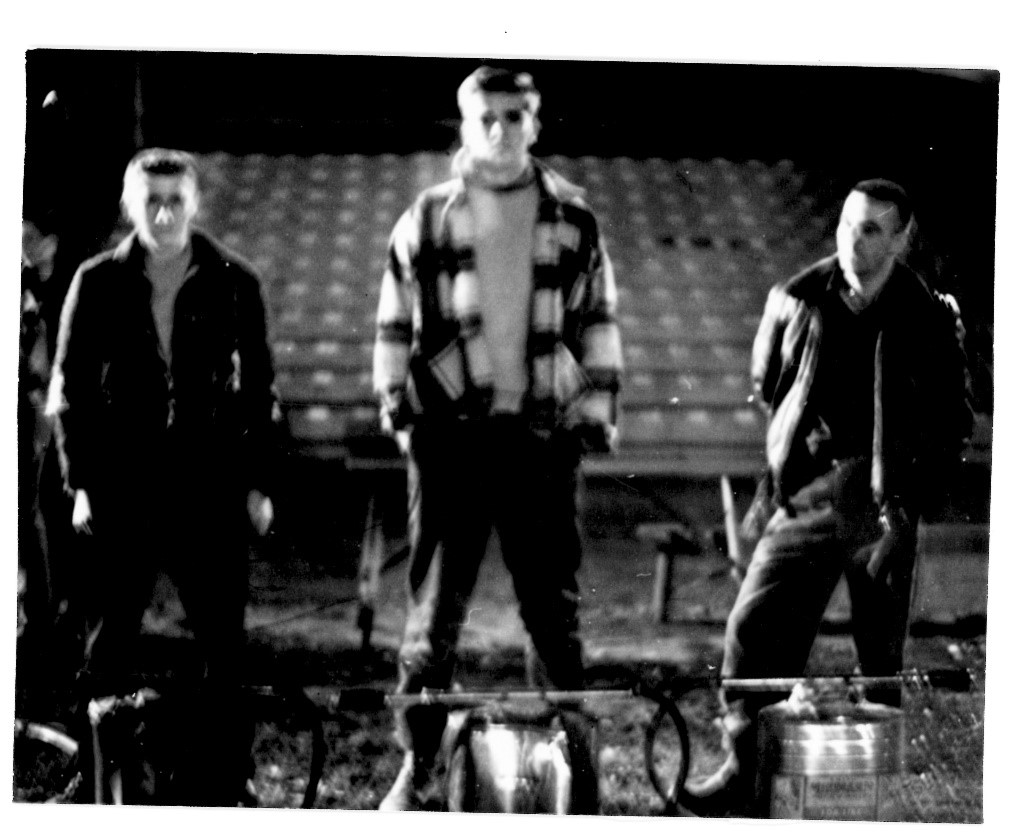
I was Bull of the Woods 3rd place winner at UNB 1961. I’m the 57 kg (125 lb) guy to the left of picture. The slightly heavier guy to the right was 2nd place winner. Both he and I grew up together in the small logging village of Millertown, NL, where we both worked in the bush before attending university to study forestry. Yes, size matters in some aspects of forestry, but not much. The visible results of that competition should encourage even-tiny females who are considering a forestry career to confidently follow their dream.
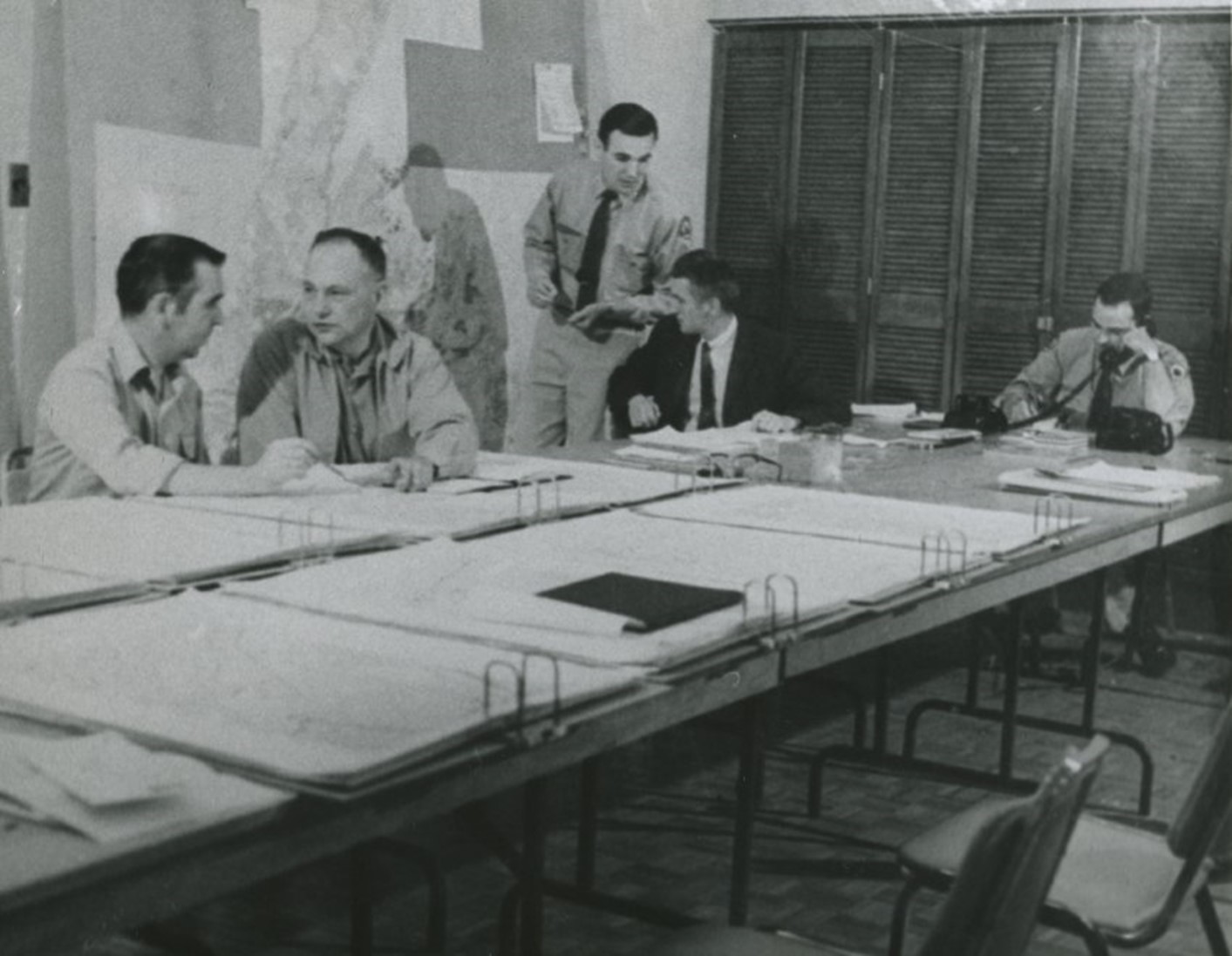
A view of the Planning Committee for the 1969 hemlock looper spray program in Newfoundland. I’m the guy in the business suit at table corner. Others represent the Canadian Forestry Service, Bowater Nfld., and Nfld. Forest Service. I was co-manager of the successful program that utilized 18 WWII Grumman TBF Avenger torpedo bomber spray aircraft operated by Skyways of BC.
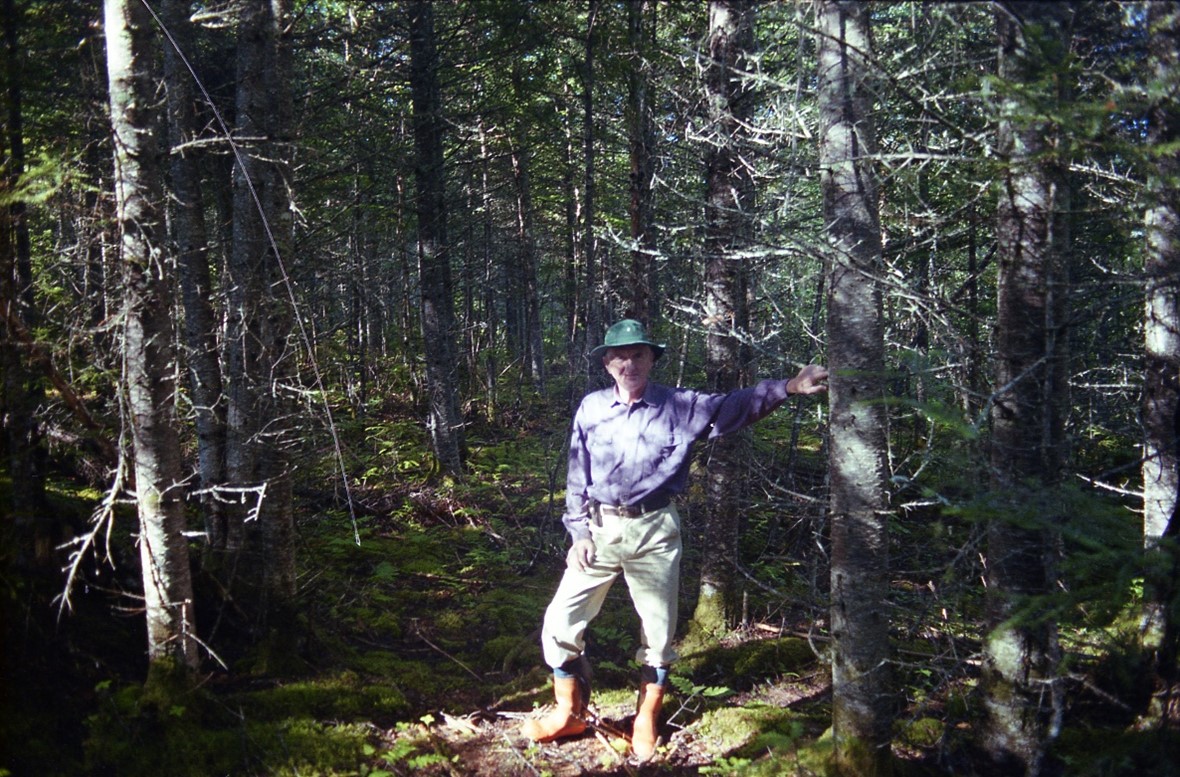
Me during 2007 in a mature stand that regenerated naturally on ground that I clearcut as a chainsaw-wielding logger in Newfoundland while waiting for a student job to begin with the federal government during the spring of 1959.
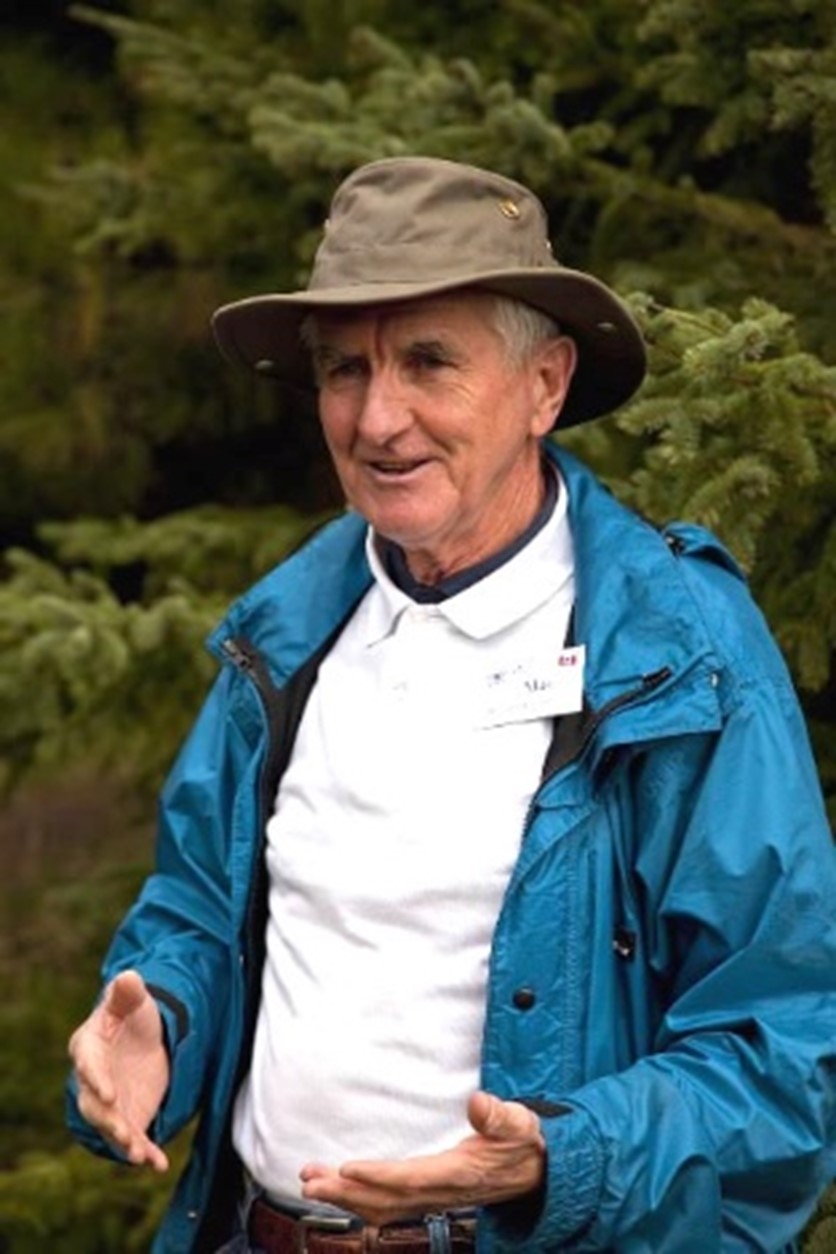
Speaking to a group of foreign tourists off a cruise ship during a bush tour I led in Thunder Bay in 2010. Photo with permission of James Benoit of Chicago, USA.
(C) 2010 James W Benoit
